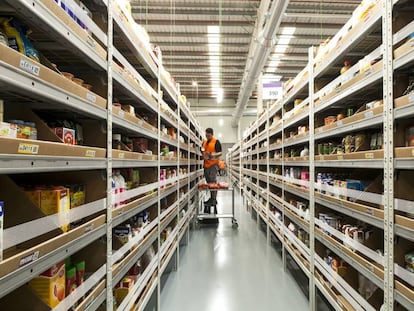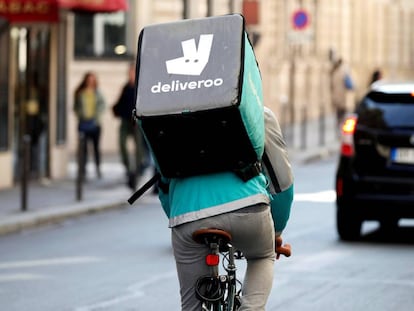The industrial town that became Spain¡¯s ¡®golden mile¡¯ of e-commerce
Coslada, northeast of Madrid, has become a major hub for the logistics industry and now commands more investor attention than the upscale Serrano street
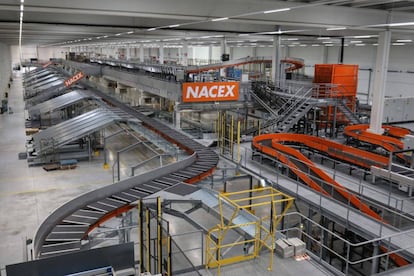

The industrial park in Coslada lacks the glamor of the elegant storefronts on Madrid¡¯s Serrano street. Nor does it have crowds of shoppers like Gran V¨ªa. Yet its warehouses have become competitors to these popular shopping venues.
Pablo Rom¨¢n is operations director for Nacex, a courier delivery company that opened a new distribution center here in November. The center spans 12,140 square meters, almost like two back-to-back soccer fields; it is a five-minute drive from the cargo terminal at Barajas airport, and 10 minutes away from downtown Madrid when there is no traffic.
In this line of business, every minute is precious
Pablo Rom¨¢n, Nacex operations chief
Rom¨¢n cannot think of a better spot in the entire Iberian peninsula to be a competitive player in an industry where online shoppers are demanding ultra-fast deliveries.
¡°We had to be in Coslada no matter what,¡± says Rom¨¢n, 54, sipping coffee inside his brightly lit office in a corner of Nacex¡¯s modern new warehouse.
Coslada, population 81,860, has grown on the back of the e-commerce boom. This and other industrial towns located along the A-2 freeway and extending northeast from Madrid to Guadalajara, have become desirable hubs for investors and companies looking to compete in a market where success is linked to speed.
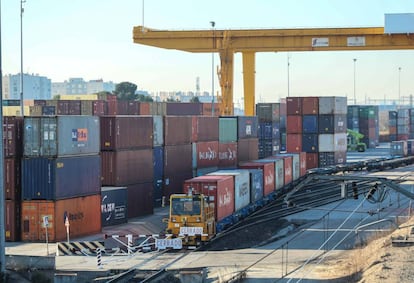
Before the internet, this was already a logistics hub where retailers would make weekly deliveries to the capital. These days, purchases made through Amazon and other online shopping platforms are delivered on a daily basis.
Rom¨¢n says that very few businesses are able to operate out of Coslada, which experts are already describing as ¡°the Golden Mile¡± of online sales. ¡°Anyone who can afford it is already here,¡± says Rom¨¢n. Nacex pays over €150,000 a month on rent. The cost per square meter would be half as much at a location 55 kilometers from Madrid, according to the consulting firm Estrada & Partners. But for Nacex, every kilometer counts. Founded in 1995, the company has found a niche thanks to its good record on punctuality, says Rom¨¢n. The new Coslada center is not a warehouse, but a space designed to load and unload at lightning speed.
Although online retail sales in Spain lag behind other European countries and the United States, for five years now there has been a booming demand for the gray warehouses that line the A-2. The demand is fed by foreign investment funds and by real estate investment trusts (known as ¡°socimis¡± in Spain) that are placing their bets on the unstoppable growth of online shopping.
Our geostrategic position is impossible to beat
Coslada Mayor ?ngel Viveros
¡°It is safer to invest in a warehouse in Coslada than on a store on Serrano street,¡± says David Mart¨ªnez, director general of Proequity, a real estate consultancy specializing in logistics. Mart¨ªnez says some investors are getting jittery about the uncertain future of bricks-and-mortar shopping, and that these feelings are affecting even Madrid¡¯s most expensive commercial street.
Near the Nacex warehouse is the food distribution center for online clients of department store giant El Corte Ingl¨¦s. And the largest courier delivery firms have distribution centers either in Coslada or in the nearby air cargo center at Barajas airport.
Because Coslada is running out of space ¨C it is now the Spanish municipality with the highest number of logistics companies, 706 ¨C the new operators are being forced to set up their hubs further away from the Madrid city center.
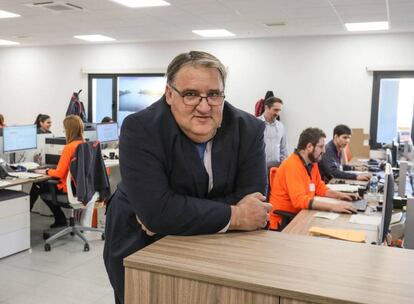
The next town after Coslada, San Fernando de Henares, is home to Amazon¡¯s second-largest Spanish plant, and several warehouses have been built here recently for logistics operations. Other corporate giants such as Inditex (owner of the fashion firm Zara) or Primark are going even further afield, to Marchamalo and Torija, which are both in Guadalajara province. The space is cheaper here, and these companies can set up oversized facilities covering nearly 100,000 square meters, the equivalent of 14 soccer fields.
Logistics land rush
The trend in Spain mirrors similar moves in New York City, where New Jersey, located across the Hudson River from Manhattan, has become a major storage and distribution center; in London, the area of choice is the East Midlands, which has good train and road connections.
In Madrid, the logistics land rush began five years ago, and each year since then has brought new records. In 2018, 931,000 square meters were scooped up in Madrid and outlying provinces, with the A-2 road as the area of choice, according to the consulting firm CBRE. The sides of the A-2 are home to 5.7 million square meters of space devoted to logistics, more than half of the total for Madrid and the provinces that it shares a border with, according to Estrada & Partners. More recently, companies have been eyeing the area south of Madrid, and settling down in towns like Getafe or even Illescas, in Toledo province, the place of choice for fashion giant H&M and for Amazon, which is due to open its largest Spanish center there in April (100,000 square meters).
It is safer to invest in a warehouse in Coslada than in a store on Serrano street
David Mart¨ªnez, Proequity
For the area between Madrid and Guadalajara known as the Corredor del Henares, this boom has breathed new life into the economy. Logistics first took off in the 1990s, with the growing importance of global trade and improved transportation networks. Many businesses decided to settle in Coslada because it is close to Barajas airport and to Puerto Seco, a railroad terminal with a customs service that¡¯s connected to Spain¡¯s four main seaports.
Some experts say that this area¡¯s potential is even greater because of the air links provided by Barajas. ¡°Asia needs a distribution point for its products going to Latin America, Europe and Africa, and Coslada is sitting in the perfect geographical spot,¡± says Francisco Aranda, the secretary general of Uno, the logistics industry association.
With the sector experiencing upheaval, it is difficult to foresee the future of logistics. In order to satisfy their clients¡¯ appetite for fast delivery, some companies, such as Seur, are creating a network of ¡°microhubs¡± in Madrid, which are larger than their traditional stores. This system solves the industry¡¯s ¡°last mile problem,¡± involving half-empty trucks driving around in the city.
But developing such a network still poses several challenges. ¡°Among other things, it remains to be seen whether those centers would be publicly or privately owned, and open to one operator or many,¡± notes Ram¨®n Garc¨ªa, innovation director for the Spanish Logistics Center association. Yet the importance of Coslada and the A-2 will not diminish, because any future logistics network would complement, not replace, the larger warehouses and distribution centers in the suburbs.
The real challenges for Coslada lie elsewhere: the increased adoption of robotics, which is eliminating jobs, and the lack of physical space. A new 156,000-square-meter tract of land has been designated for logistics use, but after that there will be no additional land left for such purposes. Half of Coslada¡¯s 11.7 square kilometers is already zoned for industrial uses, say city officials. ¡°Sadly, we can grow no more, but that won¡¯t stop Coslada from being a reference point in the transportation industry,¡± says the mayor, ?ngel Viveros. ¡°Our geostrategic position is impossible to beat.¡±
Over at the new Nacex warehouse, everything is designed to avoid delays. There are 114 docking bays for trucks and vans to load and unload simultaneously, and a classification system able to process 32,000 packages in one hour.
Near Rom¨¢n¡¯s office, three employees are monitoring screens showing movements at their 31 centers across Spain and Portugal. Rom¨¢n feels that his company is ready for the future: ¡°In this line of business, every minute is precious.¡±
English version by Susana Urra.
Tu suscripci¨®n se est¨¢ usando en otro dispositivo
?Quieres a?adir otro usuario a tu suscripci¨®n?
Si contin¨²as leyendo en este dispositivo, no se podr¨¢ leer en el otro.
FlechaTu suscripci¨®n se est¨¢ usando en otro dispositivo y solo puedes acceder a EL PA?S desde un dispositivo a la vez.
Si quieres compartir tu cuenta, cambia tu suscripci¨®n a la modalidad Premium, as¨ª podr¨¢s a?adir otro usuario. Cada uno acceder¨¢ con su propia cuenta de email, lo que os permitir¨¢ personalizar vuestra experiencia en EL PA?S.
?Tienes una suscripci¨®n de empresa? Accede aqu¨ª para contratar m¨¢s cuentas.
En el caso de no saber qui¨¦n est¨¢ usando tu cuenta, te recomendamos cambiar tu contrase?a aqu¨ª.
Si decides continuar compartiendo tu cuenta, este mensaje se mostrar¨¢ en tu dispositivo y en el de la otra persona que est¨¢ usando tu cuenta de forma indefinida, afectando a tu experiencia de lectura. Puedes consultar aqu¨ª los t¨¦rminos y condiciones de la suscripci¨®n digital.
